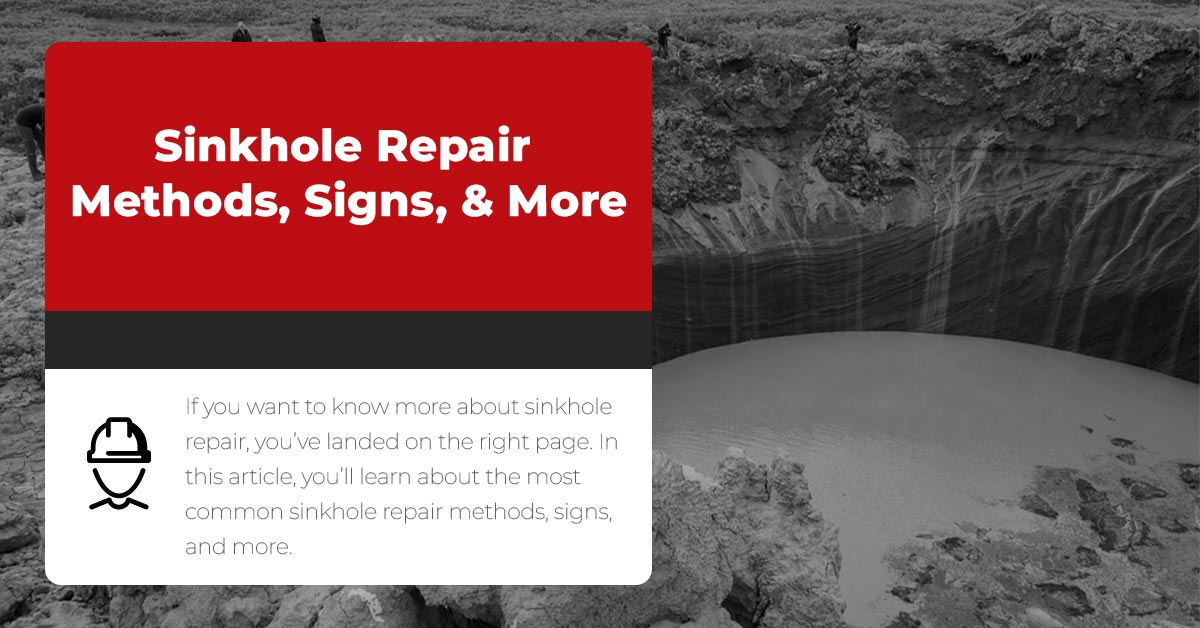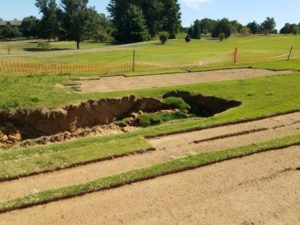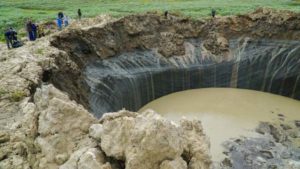If you want to know more about sinkhole repair, you’ve landed on the right page. In this article, you’ll learn about the most common sinkhole repair methods, signs a sinkhole is developing, what causes a sinkhole, and types of sinkholes. Once you’ve finished this article, you’ll have everything you need to call your local sinkhole repair contractor.
What Is A Sinkhole?
A sinkhole is a hole or depression in the ground that has no natural external surface drainage (when it rains, the water builds inside the sinkhole and drains into the subsurface, making the hole deeper). Then, when the sides of the sinkhole weaken and fall inside, it grows wider. Sinkholes can continue to grow until it’s filled and repaired or until debris plugs the bottom of the hole, turning it into a lake.
Sinkholes are commonly found in “karst terrain,” regions where groundwater can naturally dissolve subsurface rock. These rocks include salt beds, salt domes, gypsum, limestone, and other carbonate rock (rock composed primarily of carbonate minerals). Most of these rocks can be found all over the United States. The most damage from sinkholes usually occur in Texas, Missouri, Tennessee, Alabama, Kentucky, and Florida.
How Does Sinkhole Repair Work?
Sinkhole repair works by filling in the hole, along with its voids and cavities, using jet grouting, hollow bar piles, slab jacking, or underpinning. Here’s how each of those solutions work.
- Jet grouting – Contractors will inject a grout (made of either Portland cement, microfine cement, sodium silicate, acrylate, or polyurethane) into the sinkhole and surrounding soil. This grout will spread throughout the soil and voids, creating a sandstone-like mass. This process can go by different names based on the type of grout used.
- Hollow bar piles – These micropiles allow contractors to inject grout into a sinkhole without pre-drilling. The pile acts as the drill and grout casing simultaneously.
- Slab jacking – If the sinkhole forms under a concrete slab, such as your garage floor, chances are there will be gaps between the soil and concrete once the repairs are complete. In this case, contractors will drill holes into the slab and pump an expanding polyurethane foam into the void. This will stabilize your concrete slab’s weight and prevent it from sinking into the void.
- Underpinning – If a sinkhole forms underneath a larger section of your home, chances are your building will settle into the pockets below. In this case, contractors will lift your home out of the sinking soil using underpinning while they use jet grouting to fill in the voids.
Signs Of A Sinkhole
Unseen sinkholes that form under homes can show signs similar to foundation issues since both problems begin in the soil. Some of those include,
- Cracks – Almost all homes impacted by sinkhole activity develop cracks throughout the structure, including the foundation, fascia, interior walls, floors, and ceilings.
- Sloping floors – A growing sinkhole can cause parts of your home to sink or slope into the soil.
- Separations – Sinkhole formation can throw your house out of alignment, separating floors, walls, and ceilings.
- Nail popping – Sinkhole activity can cause nails to pop or push through your drywall.
- Sewer damage – Sinkholes can damage the sewer lines underneath your foundation, leading to wastewater leaks and spikes in utility bills.
- Ground issues – Holes, craters, depressions, and soft surface soil can be the earliest signs of sinkholes.
- Leaning fixed structures – If you notice fences, sheds, patios, or other structures on your property sloping into the ground, chances are a sinkhole is forming near them.
- Driveway cracks – If your driveway is dramatically sloping or collapsing in on itself, chances are a sinkhole is forming underneath.
What Causes Sinkholes?
Sinkholes are usually caused by (acidic) rainwater dissolving the soluble rock inside the soil. As the rocks dissolve, the voids grow larger and larger while the surface remains intact. Once the voids grow too large, the surface will collapse into the void, forming a sinkhole. Keep in mind voids can take hundreds or thousands of years to grow before the surface collapses, making sinkholes a “ticking time bomb.”
Types Of Sinkholes
There are four main types of sinkholes: dissolution sinkholes, cover-collapse sinkholes, subsidence sinkholes, and artificial sinkholes.
- Dissolution (solution) sinkholes – These sinkholes form very slowly in areas where there is little soil or vegetation covering the limestone or bedrock.
- Subsidence (cover-subsidence) sinkholes – These are the most common sinkholes formed from rainwater dissolving the limestone in the soil.
- Cover-collapse sinkholes – These sinkholes collapse quickly and can be very dangerous. Cover-collapse sinkholes form when a layer of clay between the bedrock and the surface suddenly opens, revealing a large void.
- Artificial (man-made) sinkholes – These sinkholes can be caused by broken sewer or water pipes, collapsed runoff storage ponds, excess irrigation pumping, collapsing abandoned mines (rare), and poorly planned drilling.
Who To Call For Sinkhole Repair
If you live in the Southeastern United States and need sinkhole repair, call Foundation Professionals Of Florida. Our team of experts will inspect the sinkhole, choose the solution that works best, and restore your home and property to its original condition. We also offer foundation repair, foundation waterproofing, crawl space repair, and more. Call today for your free inspection and estimate.




